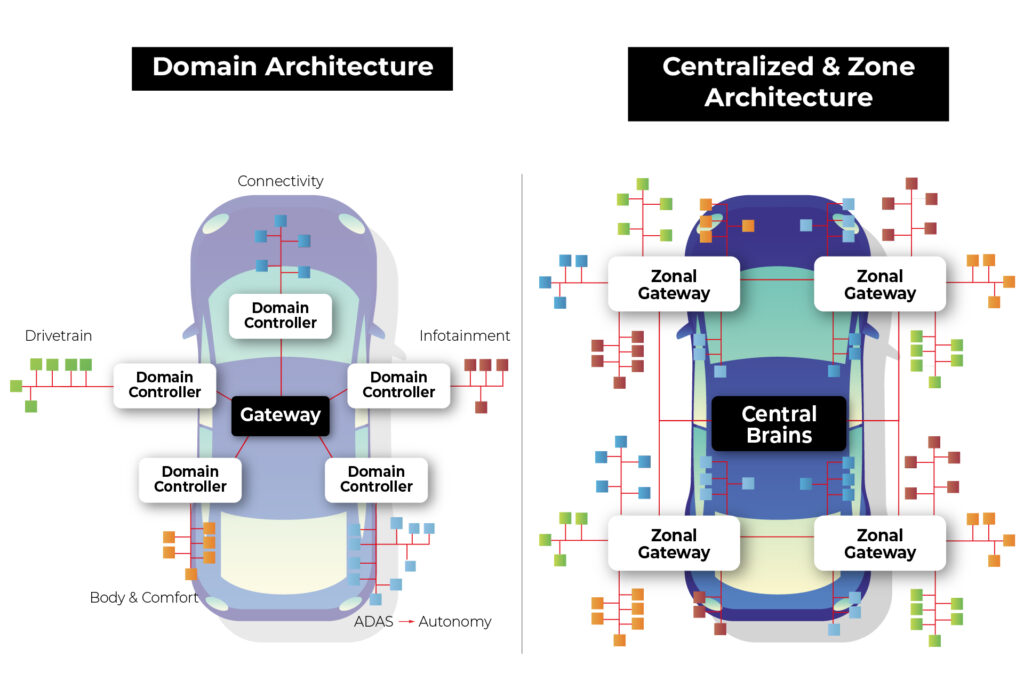Exploring the Architecture of Automotive Electronics: Domain vs. Zone

The automotive industry is undergoing a transformative shift towards electrification and automation, with vehicles becoming increasingly reliant on sophisticated electrical and electronic systems. At the heart of this evolution lies the architecture that governs how these systems are organized and integrated within the vehicle. Two prominent paradigms have emerged in this domain: domain architecture and zone architecture.

Source: https://www.eetasia.com/the-role-of-centralized-storage-in-the-emerging-zonal-automotive-architecture/
Domain Architecture: In this approach, various electrical and electronic functions are organized around “domains” or functional modules. Each domain is responsible for a specific functional area of the vehicle, such as the engine, braking system, steering system, etc. Each domain may have its independent controllers and communication networks.
Example: In a domain architecture setup, the engine domain would handle all functions related to the vehicle’s engine, including ignition, fuel injection, and emissions control. This domain would have its dedicated controller managing these operations.
Zone Architecture: In this approach, the electrical and electronic systems are organized around different “zones” within the vehicle. Zones typically correspond to specific physical areas of the vehicle, such as the front dashboard, passenger cabin, front-end, rear-end, etc. Each zone may have independent electrical and electronic systems tailored to specific needs and functions.
Example: In a zone architecture setup, the front-end zone might encompass functions like lighting, HVAC (Heating, Ventilation, and Air Conditioning), and front-facing sensors for driver assistance systems. These functions would be integrated into a system optimized for the front-end zone’s requirements.
Advantages of Zonal Architecture over Domain Architecture
In the realm of automotive electronics, zone architecture offers several advantages over domain architecture, revolutionizing the way vehicles are designed, built, and operated. Let’s explore these advantages in detail:
1. Software Defined Vehicle (SDV)
The concept of a Software Defined Vehicle (SDV) represents a paradigm shift in automotive engineering, transforming vehicles into dynamic platforms driven by software innovation. SDV involves decoupling the application layer from the hardware layer, creating a modular and flexible system that offers several significant advantages:
Abstraction of Application from Hardware: In an SDV architecture, applications are abstracted from the underlying hardware, creating a layer of abstraction that simplifies development and testing processes. This separation allows developers to focus on building software functionalities without being constrained by hardware dependencies.
Sensor Agnosticism: One of the key benefits of SDV is the ability to utilize sensors across multiple applications without being tied to specific domains. In traditional domain architectures, sensors are often dedicated to specific functions, limiting their flexibility and efficiency. In an SDV setup, sensors are treated as shared resources that can be accessed and utilized by various applications independently. This sensor agnosticism enhances resource utilization and reduces redundancy, leading to optimized system performance and cost-effectiveness.
Independent Software Updates: SDV enables independent software updates for different vehicle functions and applications. Instead of relying on centralized control units or domain-specific controllers, software functionalities can be updated and upgraded autonomously, enhancing the agility and adaptability of the vehicle.
The OTA system in zonal architecture is also simpler in general as the whole idea is based on abstracting software from hardware, and less tightly coupled software is way easier to update remotely.
With independent software updates, manufacturers can address software bugs, introduce new features and deploy security patches more efficiently. This capability ensures that vehicles remain up-to-date with the latest advancements and safety standards, enhancing user satisfaction and brand reputation.
2. Security
Zone architecture in automotive electronics offers concrete advantages over domain architecture. Let’s examine how zone architecture addresses security concerns more effectively compared to domain architecture:
Network Access Vulnerabilities in Domain Architecture:
In domain architecture, connecting to the vehicle network grants access to the entire communication ecosystem, including sensors, actuators, and the central computer.
Particularly concerning is the Controller Area Network (CAN), a widely used protocol lacking built-in authentication and authorization mechanisms. Once connected to a CAN network, an attacker can send arbitrary messages as if originating from legitimate devices.
Granular Access Control in Zone Architecture:
Zone architecture introduces granular access control mechanisms, starting at the nearest gateway to the zone. Each message passing through the gateway is scrutinized, allowing only authorized communications to proceed while rejecting unauthorized ones.
By implementing granular access control, attackers accessing the network gain access only to communication between sensors and the gateway. Moreover, the architecture enables the segregation of end networks based on threat levels.
Network Segmentation for Enhanced Security:
In a zone architecture setup, it’s feasible to segment networks based on the criticality of components and potential exposure to threats.
Less critical sensors and actuators can be grouped together on a single CAN network. Conversely, critical sensors vulnerable to external access can be connected via encrypted Ethernet connections, offering an additional layer of security.
In summary, zone architecture provides a reliable solution to security vulnerabilities inherent in domain architecture. By implementing granular access control and network segmentation, zone architecture significantly reduces the attack surface and enhances the overall security posture of automotive systems. This approach ensures that critical vehicle functions remain protected against unauthorized access and manipulation, safeguarding both the vehicle and its occupants from potential cyber threats.
3. Simplified and Lightweight Wiring
Wiring in automotive electronics plays a critical role in connecting various components and systems within the vehicle. However, it also poses challenges, particularly in terms of weight and complexity. This section, explores how zone architecture addresses these challenges, leading to simplified and lightweight wiring solutions.
The Weight of Wiring: It’s important to recognize that wiring is one of the heaviest components in a vehicle, trailing only behind the chassis and engine. In fact, the total weight of wiring harnesses in a vehicle can reach up to 70 kilograms. This significant weight contributes to the overall mass of the vehicle, affecting fuel efficiency, handling, and performance.
Challenges with Traditional Wiring: Traditional wiring systems, especially in domain architecture, often involve long and complex wiring harnesses that span the entire vehicle. This extensive wiring adds to the overall weight and complexity of the vehicle, making assembly and maintenance more challenging.
The Promise of Zone Architecture: Zonal architecture offers a promising alternative by organizing vehicle components into functional zones. This approach allows for more localized placement of sensors, actuators, and control units within each zone, minimizing the distance between components and reducing the need for lengthy wiring harnesses.
Reduced Cable Length: By grouping components together within each zone, zone architecture significantly reduces the overall cable length required to connect these components. Shorter cable runs translate to lower electrical resistance, reduced signal attenuation, and improved signal integrity, resulting in more reliable and responsive vehicle systems.
Optimized Routing and Routing Flexibility: Zone architecture allows for optimized routing of wiring harnesses, minimizing interference and congestion between different systems and components. Moreover, the flexibility inherent in zone architecture enables easier adaptation to different vehicle configurations and customer preferences without the constraints imposed by rigid wiring layouts.
4. Easier and Cheaper Production
Zonal architecture not only enhances the functionality and efficiency of automotive electronics but also streamlines the production process, making it easier and more cost-effective. Let’s explore how zone architecture achieves this:
Modular Assembly: One of the key advantages of zone architecture is its modular nature, which allows for the assembly of individual zones separately before integrating them into the complete vehicle. This modular approach simplifies the assembly process, as each zone can be constructed and tested independently, reducing the complexity of assembly lines and minimizing the risk of errors during assembly.
Reduced Wiring Complexity: The reduction in wiring complexity achieved through zone architecture has a significant impact on production costs. Wiring harnesses are one of the most expensive components in a vehicle, primarily due to the labor-intensive nature of their installation. Each wire must be routed and connected individually, and since each domain typically has its own wiring harness, the process becomes even more laborious.
Automation Challenges with Wiring: Furthermore, automating the wiring process is inherently challenging due to the intricate nature of routing wires and connecting them to various components. While automation has been successfully implemented in many aspects of automotive production, wiring assembly remains largely manual, requiring a significant workforce to complete the task efficiently.
Batch Production of Zones: With zone architecture, the assembly of individual zones can be batch-produced, allowing for standardized processes and economies of scale. This approach enables manufacturers to optimize production lines for specific tasks, reduce setup times between production runs, and achieve greater consistency and quality control.
Integration of Wiring Harnesses: Another advantage of zone architecture is the integration of wiring harnesses into larger assemblies, such as the entire zone. By combining wiring harnesses and assembly for an entire zone into a single process, manufacturers can significantly accelerate production and reduce costs associated with wiring installation and integration.
In summary, zone architecture simplifies and streamlines the production process of vehicles by allowing for modular assembly, reducing wiring complexity, addressing automation challenges, and facilitating batch production of zones. By integrating wiring harnesses into larger assemblies and optimizing production lines, manufacturers can achieve cost savings, improve efficiency, and enhance overall quality in automotive production.
Introduction to Zone Architecture Demonstration
In our Research and Development (R&D) department, we’re thrilled to present a demonstration showcasing the power and versatility of zone architecture in automotive electronics. Let’s take a closer look at the key components of our setup:

1. Android Computer with Modified VHAL for HVAC:
- Our central computing platform is an Android 14 device running Android Automotive OS (AAOS). This device serves as the hub for system control and communication.
- The modified Vehicle Hardware Abstraction Layer (VHAL) is a pivotal component of our setup. This software layer enables seamless interaction with the vehicle’s HVAC module.
- The modified VHAL establishes a connection with the HVAC module through Ethernet and REST API communication protocols, facilitating real-time control and monitoring of HVAC functions.
2. Zone Computer with Ubuntu Core and HVAC Controller Application:
- Each zone in our architecture is equipped with a dedicated computer running Ubuntu Core.
- These zone computers act as the brains of their respective zones, hosting our custom HVAC controller application.
- The HVAC controller application, developed in-house, is responsible for interpreting commands received from the central Android computer and orchestrating HVAC operations within the zone.
- By leveraging Ethernet and REST API communication, as well as the Controller Area Network (CAN) network, the HVAC controller application ensures seamless integration and coordination of HVAC functions.
3. Microcontroller for Physical Interface:
- To provide users with intuitive control over HVAC settings, we’ve integrated a microcontroller into our setup.
- The microcontroller serves as an interface between the physical controls (buttons and display) and the zone computer.
- Using the CAN interface, the microcontroller relays user inputs to the zone computer, enabling responsive and interactive control of HVAC parameters.
- By bridging the gap between the digital and physical domains, the microcontroller enhances user experience and usability, making HVAC control intuitive and accessible.
The experiment with zone architecture in automotive electronics has proven the effectiveness of our setup. In our solution, pressing a button triggers the transmission of information to the zone computer, where the temperature is adjusted and broadcasted to the respective temperature displays in the zone and to the main Android Automotive OS (head unit IVI). Additionally, changing the temperature via the interface on Android results in sending information to the appropriate zone, thereby adjusting the temperature in that zone.
During the hardware layer testing, we utilized the REST API protocol to expedite implementation. However, we observed certain limitations of this solution. Specifically, we anticipated from the outset that the REST API protocol would not suffice for our needs. The VHAL in the Android system needs to know the HTTP addresses of individual zones and specify to which zone the temperature change should be sent. This approach is not very flexible and may introduce delays associated with each connection to the HTTP server.
In the next article, we plan to review available communication protocols and methods of message description in such a network. Our goal will be to find protocols that excel in terms of speed, flexibility of application, and security. By doing so, we aim to further refine our solution and maximize its effectiveness in the context of zone architecture in automotive electronics.
Check related articles
Read our blog and stay informed about the industry's latest trends and solutions.
see all articles

How to Build Software Architecture for New Mobility Services – Gathering Telemetry Data
Read the article




